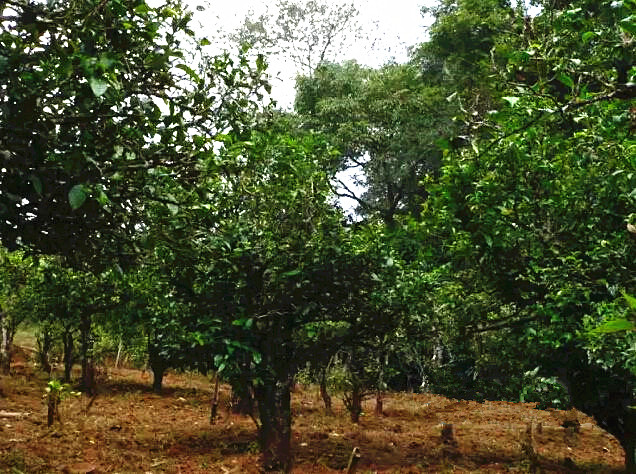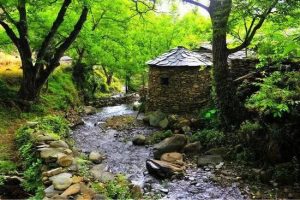Zhangwai Village and Tea Plantation of Dongbanshan Mountain in Mengku Town, Lincang
Chinese Name: 勐库东半山:章外村
English Name: Zhangwai Village of Dongbanshan Mountain in Mengku Town, Lincang
Zhangwai tea area(章外茶区)
Zhangwai is an old tea district in Shuangjiang. Now there are many ancient tea gardens in Ming and Qing Dynasties and in the period of the Republic of China.
Zhang Wai was once under the jurisdiction of Mengku Town in the early days of the founding of New China. And then it was classified as Heliu Town (贺六乡) in the 1980s. Heliu Town was merged into Mengku town in 2006, and Zhang Wai was also classified as Mengku town. Zhang Wai is far from Mengba and closer to Mengku Basin. Because Zhangwai is close to Mengku and connected with Haigong, Zhangwai is assigned to the ancient tea garden in the eastern half of Mengku Mountain in the division of tea districts. Zhangwai is now a village committee in Mengmeng Town. There are more than 10 natural villages in size. The ancient tea gardens in Zhangwai are mainly distributed in Yingpan Village(营盘村), Shangzhangwai Village(上章外村) and Xia Zhangwai Village(下章外村), Shitouzhai(石头寨) and Xinzhai(新寨) . These ancient tea villages are connected by an earthen road.
Yingpan Village(营盘村)
Yingpan village is located on the high side of the road with an elevation of about 1800 meters. The earliest inhabitants of Yingpan village are Lahu people. Now it is a Han people’s village with 50 families. Lahu people planted many tea trees in Yingpan. Now there are more than 10 remaining trees. The tree circumference is more than 80 centimeters, and the growth is very good.
Shangzhangwai (上章外)
Shangzhangwai Village(上章外村) is the largest village in Zhangwai Village, with 80 families and only 3 Lahu families. Sporadic tall ancient tea trees with a tree circumference of more than 100 cm can be seen on the hillsides around Shangzhangwai. These tea king trees are planted by Lahu people. Zhangwaihe River flows through the middle of Shangzhangwai village. There are ancient tea gardens on the slopes of both sides of the river, which were planted by Han people in the late Qing Dynasty and the early Republic of China.
Before 1949, Zhangwai Tea had become famous in Boshang Street(博尚街). Businessmen in Lincang Basin often rushed to buy tea in Zhangwai. The natural environment conditions in Shangzhangwai(上章外) are good, the land is rich in fertilizer and water, the fields are abundant, the tea garden is abundant, the economic strength is very strong. Although the villages are few, the people in the eastern and western half mountain not dare to look down on Shangzhangwai.
Shitouzhai Village(石头寨)
There are 18 families in Shitouzhai Village, one of which is Lahu ethnic people and the rest is Han. The ancient tea gardens in Stone Village are the most in several villages of Zhangwai. Most of them are left by Lahu people. After the second great uprising of Lahu people was suppressed by the Qing government in 1887, they moved out of Shitouzhai Village(石头寨). The Han people moved in and took over the remaining tea gardens. Some new tea gardens were planted. After 1958, Shangzhangwai and Shitouzhai Village(石头寨) planted another five or six hundred acres tea gardens. The tea gardens in the two villages were connected.
Xiazhangwai (下章外)
Xiazhangwai consists of two small villages, together with more than 60 families. The villages above are called the first group(Erzu/一组) and the villages below are called the second group(Erzu/二组). The first group, also known as Yang Jiazhai(杨家寨), has 21 families, mostly surnamed Yang(杨). Because there are many paddy fields, there are not many tea trees planted .
Several villages in Zhangwai have tea gardens planted in the early years of the Republic of China. There are a few old tea gardens planted on the hillside and in the middle of the new-style platform tea gardens. By 1950, the area of tea gardens had been very large. In 1954, Shuangjiang Tea Station had set up a purchasing point in Zhangwai. By 1955, 12,000 Jin tea was collected. At that time, there are only about 100 or so families in total in Zhangwai, so the output was not low.
Zhangwai is very close to Mengku, and once belonged to Mengku. Mengku people recognize Zhangwai tea(章外茶) as Mengku tea. Zhangwai tea is different from the tea in other villages in Mengku. One can feel sweet as soon as tasting it. Tea makers all like Zhangwai tea.
Zhangwai (章外) is an ancient tea-producing area in Shuangjiang, Yunnan Province, known for preserving numerous tea gardens from the Ming and Qing dynasties, as well as those from the Republican era. Located in the southeastern part of Dongbanshan Mountain in Mengku Town, Zhangwai is only 15 kilometers from Mengku Dazi, with an average elevation of 1,800 meters. The region enjoys mild winters, cool summers, and distinct dry and wet seasons, making it an ideal environment for cultivating Mengku large-leaf tea.
Historical Context
After the founding of New China, Zhangwai was initially under the administration of Mengku Town. In the 1980s, it was incorporated into Heluxiang, which was later merged into Mengmeng Town in 2006. Zhangwai is situated closer to Mengku Dazi than Mengmeng Dazi, leading to its classification as part of the ancient tea gardens of Mengku East Mountain. Today, it is a village committee of Mengmeng Town, consisting of about ten natural villages, with ancient tea gardens primarily found in Yingpan Village, Upper and Lower Zhangwai, Shitouzhai, and Xinzai.
Key Areas within Zhangwai
- Yingpan Village
Located along a main road at an elevation of approximately 1,800 meters, Yingpan Village was initially settled by the Lahu ethnic group but is now predominantly Han Chinese. The village has 50 households, and remnants of ancient tea trees, some over 80 centimeters in circumference, still flourish here. - Upper Zhangwai
As the largest village in Zhangwai, Upper Zhangwai has around 80 households, with only three being Lahu. The area is dotted with large ancient tea trees, some exceeding 100 centimeters in circumference, planted by the Lahu people. The Zhangwai River flows through this village, and both banks feature ancient tea gardens planted during the late Qing Dynasty and early Republic of China. - Lower Zhangwai
Comprising two smaller villages with over 60 households, Lower Zhangwai includes a community known as Yangjiazhai, with 21 households primarily bearing the surname Yang. Due to the abundance of rice fields, there are fewer tea trees cultivated in this area.
Historical Significance of Zhangwai’s Tea Production
Zhangwai’s tea gained popularity before 1949, with merchants from Lincang frequently visiting to purchase tea. The village’s favorable natural conditions—fertile soil and abundant water—have contributed to its strong economic position, making it a respected tea-producing area.
The old tea gardens in Zhangwai, cultivated during the early Republic of China, are interspersed among newer terraced tea gardens. By the 1950s, the tea garden area had expanded significantly, leading to the establishment of a purchasing station by the Shuangjiang Tea Station in 1954. In 1955, the villages collectively produced over 12,000 jin (about 6,000 kg) of dried tea, a considerable yield for a population of just over 100 households.
Zhangwai tea is distinguished from other Mengku teas, with a quick and pleasant aftertaste that is favored by tea producers. The villagers regard Zhangwai tea as part of the Mengku tea heritage due to its historical ties.
Shitouzhai
Shitouzhai currently has 18 households, with one Lahu family and the rest being Han. This village boasts the largest number of ancient tea gardens in Zhangwai, primarily left by the Lahu. After the second Lahu uprising in 1887, the Qing government suppressed the rebellion, leading to the migration of the Lahu people and the influx of Han settlers who took over the tea gardens and planted new ones. Following 1958, Upper Zhangwai and Shitouzhai expanded their tea garden areas by an additional 500-600 acres, with the two villages’ gardens now interconnected.
Zhangwai’s Ancient Tree Tea
Zhangwai’s ancient tree tea is characterized by tightly twisted leaves, rich buds, and strong aromas. The tea has a robust flavor with a lingering sweetness that is quick to develop, displaying a bold and assertive character. The unique qualities of Zhangwai tea have made it highly regarded among tea enthusiasts and producers alike.
















